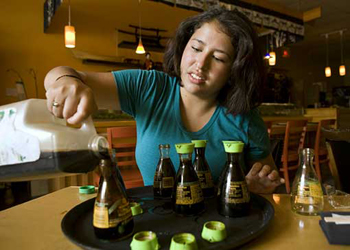COVER STORY SIDEBAR
For some returning students, financial aid meets desperate need
Like many students, Evelyn Ambriz '11, a 19-year-old development sociology major from Garland, Texas, had to find a way to pay for her education when her financial aid package fell short her freshman year.
But more than most, her need was extreme. Her parents are immigrants from Guanajuato, Mexico, with service jobs in Dallas and a combined income of $32,000.

Evelyn Ambriz '11 See larger image
"I always wanted to go to college, but my parents didn't even go to elementary school," she said.
But she was determined to go to Cornell, even though it offered less money than other institutions she applied to, and she was accepted by the College of Agriculture and Life Sciences (CALS).
"Financial aid was actually a setback for me," she said in July. "I actually thought about transferring to NYU [New York University] for next year, [but] the financial aid statement was way, way too much. Cornell's new financial aid definitely played a huge part in deciding to stay here."
As of Sept. 3, her financial aid for 2008--09 had been reviewed and she qualified for zero loan debt under the new initiative, according to the Office of Financial Aid and Student Employment (OFASE). The estimated current annual cost of attendance at CALS is $46,840 for out-of-state students.
As Ambriz's case illustrates, the new financial aid initiative is not just for freshmen. Returning undergraduate students also are eligible for tuition assistance intended to minimize their student loan debts.
"I would say that there would be very few [returning] students whose aid packages would not be better," said Tom Keane, director for scholarships and policy analysis for OFASE.

Tom Keane, director of financial aid for scholarships and policy analysis.
However, Keane indicated, the workload involved in processing applications, combined with training new staff and implementing new technology over the summer, caused some delays in delivering financial aid packages to all students before classes started Aug. 28.
Typically, about 50 percent of freshmen who apply for need-based financial aid are eligible for it, Keane said. Since many continuing students who were turned down once for aid will not reapply, about 90 percent of those who do reapply will be eligible. And some who were refused before will reapply anyway, in the hope of receiving aid under the new initiative.
Average loan debt for many students is expected to be $4,000 to $5,000 less than the $7,500 average reported in 2007--08, Keane said.